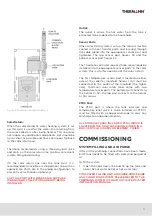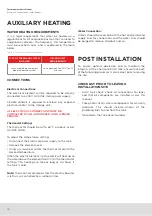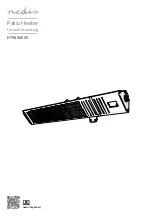
777
SITE INSPECTION
STORAGE TANK LOCATION
• The storage tanks are to be installed at ground or
floor levele and must stand vertically upright as the
manufacturer has intended.
• The storage tanks are able to be installed indoors or
outdoors.
• The storage tanks are to be installed at ground or
floor level and must stand vertically upright as the
manufacturer has intended.
• The storage tank should be located as close as
the building such as the bathroom or kitchen. If the
storage tank is located a long way from hot water
draw points, a hot water circulation loop on a timer
may be considered to reduce the time-lag for water
to heat up and resultant water wastage.
• The tank should not obstruct any windows, doors
or exits and should cause minimal intrusion to the
existing site. Clearances must be allowed for to make
servicing and maintenance convenient without the
must also be easily accessible.
• For glass-lined tanks, consider the positioning
of the tank to allow room for anode removal and
replacement maintenance.
• The storage tank must be installed in a properly
drained safe tray where leakage may otherwise
cause damage. The installation of the storage tank
and safe tray must comply with AS/NZS 3500.4 and
all local codes and regulatory authority requirements
with regards to its construction, installation and
draining. Tanks installed outside must be installed on
a suitable concrete slab.
• The tank label must be clearly visible.
TRANSPORTATION AND UNPACKING
Transportation of Components
:
When transporting boxes, note the orientation of the
“THIS WAY UP” arrows.
• Ensure all boxes are strapped and secured to prevent
movement during transit.
• All tanks must be transported upright. Stacking is
not recommended for any tanks.
• Products should always be handled with care.
Damage incurred during the transportation is not
covered under product warranty.
Unpacking of Components:
• When unpacking, take care to ensure that the
components are not damaged in the process.
• Avoid using sharp blades or knives as this can
scratch the surfaces of the products particularly the
tanks.
777
SITE INSPECTION
STORAGE TANK LOCATION
• The storage tanks are to be installed at ground or
floor levele and must stand vertically upright as the
manufacturer has intended.
• The storage tanks are able to be installed indoors or
outdoors.
• The storage tanks are to be installed at ground or
floor level and must stand vertically upright as the
manufacturer has intended.
• The storage tank should be located as close as
the building such as the bathroom or kitchen. If the
storage tank is located a long way from hot water
draw points, a hot water circulation loop on a timer
may be considered to reduce the time-lag for water
to heat up and resultant water wastage.
• The tank should not obstruct any windows, doors
or exits and should cause minimal intrusion to the
existing site. Clearances must be allowed for to make
servicing and maintenance convenient without the
must also be easily accessible.
• For glass-lined tanks, consider the positioning
of the tank to allow room for anode removal and
replacement maintenance.
• The storage tank must be installed in a properly
drained safe tray where leakage may otherwise
cause damage. The installation of the storage tank
and safe tray must comply with AS/NZS 3500.4 and
all local codes and regulatory authority requirements
with regards to its construction, installation and
draining. Tanks installed outside must be installed on
a suitable concrete slab.
• The tank label must be clearly visible.
TRANSPORTATION AND UNPACKING
Transportation of Components
:
When transporting boxes, note the orientation of the
“THIS WAY UP” arrows.
• Ensure all boxes are strapped and secured to prevent
movement during transit.
• All tanks must be transported upright. Stacking is
not recommended for any tanks.
• Products should always be handled with care.
Damage incurred during the transportation is not
covered under product warranty.
Unpacking of Components:
• When unpacking, take care to ensure that the
components are not damaged in the process.
• Avoid using sharp blades or knives as this can
scratch the surfaces of the products particularly the
tanks.


































